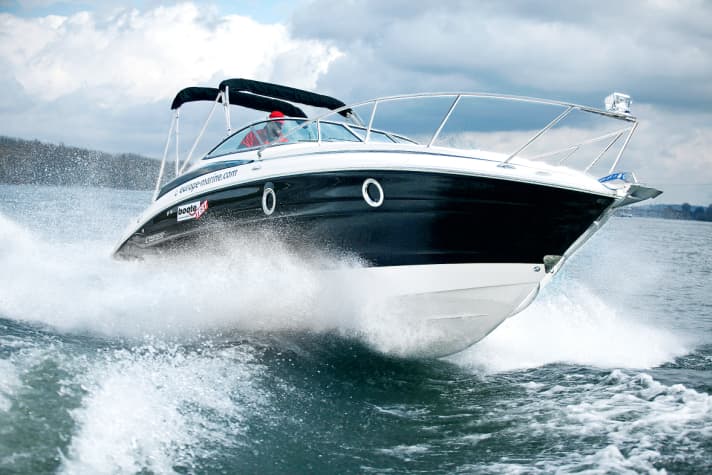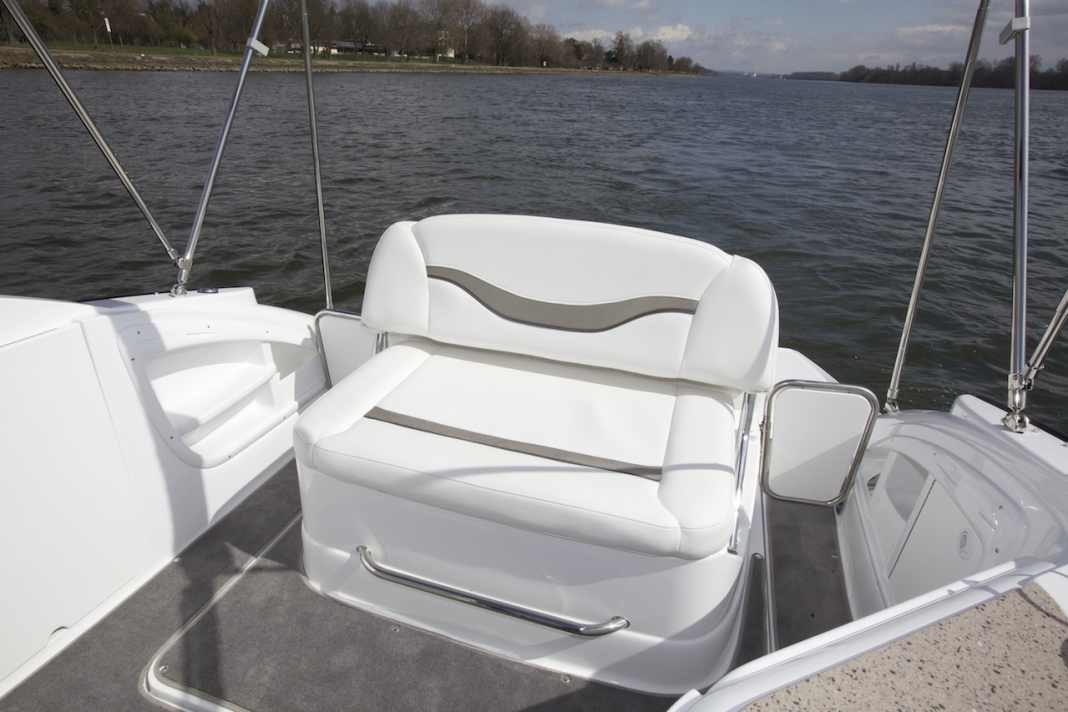







The boatbuilding history of Cruisers Yachts, based in Oconto, Wisconsin, dates back to 1904, when the "Thompson Bros. Boat Manufacturing Co." started their family business. In the early 1990s, the shipyard was sold and renamed "Cruisers Yachts".
The ideal crew for our test boat Cruisers 275 consists of four people, at least if you also want to spend the night on board. In this case, "big and small" are advantageous, i.e. two adults and two children. The Cruisers is also a good partner for those who just want to go for a nice swim or a relaxing trip with friends. The large cockpit with variable seat/lounger combination, the wet bar and an expansive bathing platform including a long bathing ladder ensure unadulterated enjoyment.
The shipyard plays it safe with regard to the sailing area and classifies its boat in category C (coastal waters). If you want to transport it by land, you will have to choose a more complex transporter than the 3500 kg trailer with ball head coupling, because even unloaded the Cruisers 275 Express weighs 3085 kg, which even a light aluminium trailer cannot make up for. Weight is often a sign of solid construction, which is confirmed by a look behind the scenes. Apart from a few sharp cut edges on the cut-outs and corners of the bow berth, the plastic workmanship is of a good American standard.
Driving and manoeuvring
When it comes to engines, Cruisers is no different to its competitors: the main choice is still petrol engines. For the Cruisers 275, these are all V-8 engines from Mer-Cruiser and Volvo Penta. We drove the test boat with a MerCruiser 377 MAG (325 hp), which delivers its power to the water via a Bravo Three-Z drive and twin propeller. The fact that the latter is the right choice was demonstrated by the full throttle speed of 5200 rpm achieved. It is exactly at the maximum speed permitted by the manufacturer.
This means that there is still enough power available for a fully loaded boat. In the acceleration phase, the bow rises from around 1500 rpm and slowly lowers again around 3000 rpm. If you use the trim tabs in this situation, you have an unrestricted view forwards. Without the flaps, the 275 Express also makes it over the hill without any problems, but the seated rider then has a brief view of the bow. As the speed increases, the flaps should be fully raised again and the test boat is brought into the correct position using the power trim. At maximum, this is well ½ on the display.
Whether gliding slowly or fast, the Cruiser runs safely and stays on course. This also applies when crossing the inland waterway waves on the Rhine at Budenheim, where the hull is soft and dry. In fast bends, she pulls round tightly and tends to rock a little at the very end, which is not unusual for boats with stepped hulls. The centrifugal forces that occur are normally sustainable, which also applies when the skipper is slaloming or abruptly wrenching the steering wheel. The steering is very easy to turn for all manoeuvres.
Water skiing and tubing is possible behind the Cruisers, but its wake is not exactly flat. The more you use the power trim, the flatter it becomes, which in turn increases the splash water fountain. To make distance, you let the V-eight turn 3500 rpm and glide economically across the water at just under 24 knots. The fuel consumption is then 1.63 l/sm, which together with the 257-litre tank gives a range of 134 nm plus 15% reserve. An acceptable value for such a fast cruiser. - For full-throttle fans (39.2 kn), the fun is over after 95 nm; for canal cruising, the range is around 140 nm.
At displacement speed, the skipper has to correct the course slightly from time to time. In the harbour, the Cruisers 275 exhibits agile behaviour. It is steered using an elegant, height-adjustable sports steering wheel and shifted using a smooth and precise single-lever gearstick. The shipyard has positioned both well. Apart from the compass, this also applies to the instruments and rocker switches. The driver sits on a wide, firmly upholstered bench seat with plenty of knee room.
Passengers take a seat on the sunbed bench on the port side. There is only a backrest or windscreen frame to hold on to, in which a slightly green-tinted safety glass pane sits. To prevent the driver from being blinded by rain and spray, the shipyard installed a windscreen wiper on his side with a sufficiently large field of vision. There were no defroster nozzles. Large foil windows all round the assembled convertible top guarantee a good overview.
Engine, tank, electrics
Cruisers also have the engine under the sunbed, which opens electrically at the touch of a button. The shipyard installs an inspection hatch in the cockpit floor under the rear bench so that the hatch can be lifted if the electrics fail. From there, the bolt can be pulled out of the lifting rod. Inspection and service work can be carried out easily when the hatch is open. The ventilation works reasonably well, as shown by the maximum engine compartment temperature of 25° C at an air temperature of 15° C.
Installations: Here, the technicians did a neat job with firm plastic clamps and cable ties. The fuel hose connections, some of which are only secured with a screw clamp, are not suitable. The petrol is cleaned via the filter on the engine, shut off via a spring valve with ball in the intake line. The two batteries, which are securely fastened in a tray (with screws and a plastic bracket), are switched via a selector switch, which is well positioned at the cockpit stern entrance on the port side. There you will also find a main fuse, other automatic switches are located directly at the switch on the control stand and at a control centre near the underfloor cabin entrance.
Security
To get to the foredeck, the route leads via the centre passageway with two steps moulded into the cabin door. There are no handholds further along the foredeck, and in rough seas it is better to crawl on all fours to the sturdy railing. In the cockpit, there is only a handle in the footwell of the bench, otherwise there are only the windscreen frame, canopy poles and backrest. There are two doors on either side of the bathing platform, which ensures safety, especially for children in the cockpit. You can climb from the cool water onto the platform using the standard bathing ladder, which can be folded out easily enough from the water.
The safety equipment includes two electric bilge pumps, but these do not replace the manual bilge pump that is standard on the BOOTE. On the positive side, there is a standard fire extinguishing system in the engine compartment; on the negative side, the foam insulation (with aluminium foil) can be ignited in no time at all with a lighter flame.
Living and equipment
There is a convertible seating area in the bow, which has a suitable width of 1.65 m, while the length of the berths is a modest 1.60 m (distance between bow backrest and foot end). At 2.10 m, taller people have a better chance of stretching out in the underfloor cabin. The pantry block with a standing height of 1.80 m is located between the forward and underfloor berths. With a 1-burner hob, microwave, sink, refrigerator, suitable storage space and a moderate work surface, the 275 Express has the typical layout of an American cruiser. The wet room (pump toilet, washbasin and shower), which has a headroom of around 1.65 metres, matches this.
Those who love open-air fun can head to the cockpit, which has a cushion combination in the stern that can be converted into different benches and loungers using the backrest. Additional sun cushions are available for the bow for an extra charge, and after a swim you can shower off at the stern shower on the deep bathing platform. There is a wet bar in the cockpit with a sink, work surface and - indispensable from an American perspective - an ice box for preparing small snacks and chilling fruit and drinks.
If you want to "party hard" on your boat, you can have the normal sound system replaced with a "Premium Sound System" for an extra 2,000 euros. You also pay extra for a camper cover, cockpit tarpaulin, generator, air conditioning, underwater lighting, equipment carrier and complete anchor gear. The shipyard provides six retractable cleats as standard for mooring, and a sufficiently solid rubbing strake provides all-round protection. Railings, cleats and canopy poles are available for attaching fenders
Data sheet: Cruisers Sport Series Express 275
Shipyard: Cruisers Yachts
Type designation: Cruisers Sport Series Express 275
CE category: C - Coastal waters
Material of hull and deck: Plastic
Length: 8,56 m
Width: 2,54 m
Displacement: 3,09 t
Price: 103.604,00 €

